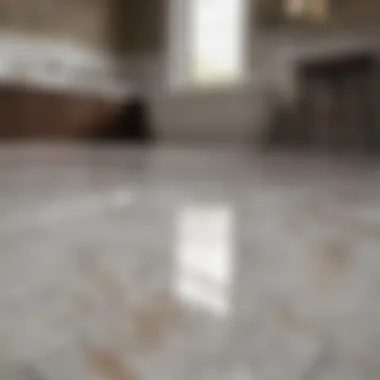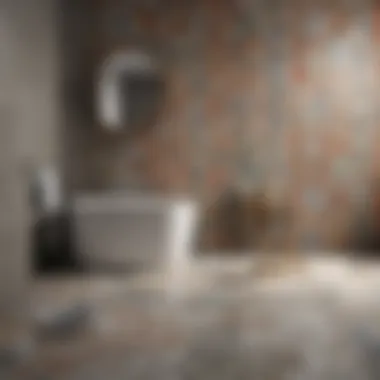Materials:
Before starting your bathroom floor tiling project, it's crucial to gather all the necessary materials to ensure a smooth process. Here is a detailed list of what you will need:
- Tiles: Measure the area carefully to determine the quantity of tiles required. Opt for high-quality ceramic or porcelain tiles for durability.
- Grout: Choose a grout color that complements your tiles and suits your aesthetic preferences.
- Adhesive: Purchase adhesive suitable for your chosen tiles, ensuring a strong and lasting bond.
- Spacers: Use spacers to maintain consistent gaps between tiles for a professional finish.
- Tile Cutter: Invest in a tile cutter to achieve precise cuts where needed.
- Trowel: Select a trowel of the appropriate size for spreading adhesive smoothly.
- Level: Ensure your tiles are laid evenly with the help of a level.
- Sponge and Bucket: Have a sponge and bucket handy for cleaning excess grout during the installation process.
- Grout Float: Use a grout float for efficient grout application and finishing touches.
With these materials ready, you are equipped to begin the tiling process in your bathroom.
DIY Steps:
Embarking on a bathroom floor tiling project requires meticulous planning and execution. Follow these detailed instructions for a successful outcome:
- Prepare the Surface: Ensure the existing floor is clean, dry, and level. Make any necessary repairs before proceeding.
- Dry Lay Tiles: Before applying adhesive, dry lay the tiles to determine the layout and make any adjustments as needed.
- Apply Adhesive: Use the trowel to spread adhesive on the floor, working in small sections.
- Lay Tiles: Place the tiles carefully, using spacers to maintain uniform gaps between each tile.
- Cut Tiles: Use the tile cutter to make precise cuts for edges and corners.
- Grout the Tiles: Once the adhesive has set, apply grout using a grout float. Wipe off excess grout with a damp sponge.
- Seal Grout (Optional): Consider sealing the grout for added protection against moisture and stains.
Following these step-by-step instructions will help you achieve a beautifully tiled bathroom floor with professional results.
Technical Aspects:
To ensure the quality and longevity of your bathroom floor tiling project, consider the following technical aspects:
- Tools: Apart from the basic tools mentioned earlier, you may also need a rubber mallet for tapping tiles into place.
- Timing: Allow the adhesive to set according to the manufacturer's instructions before grouting the tiles.
- Techniques: When grouting, use diagonal movements to press the grout into the gaps thoroughly.
These technical considerations will enhance the precision and durability of your tiled bathroom floor.
DIY Project Process:
As you progress through the installation of your bathroom floor tiles, keep in mind these sequential steps:
- Key Techniques: Ensure tiles are laid in a staggered pattern for a professional look and optimal strength.
- Timings: Work efficiently to avoid adhesive setting before you lay the tiles, which can impact adhesion.
Should you encounter any challenges during the tiling process, here are some troubleshooting tips:
- Uneven Tiles: Adjust the amount of adhesive or check for inconsistencies in the subfloor.
- Grout Concerns: If the grout is not setting correctly, double-check the mixing ratio and application.
- Tile Alignment: Use a straight edge to realign tiles if they have shifted during installation.
By following these sequential steps and troubleshooting strategies, you can overcome common hurdles and achieve a stunning bathroom floor tiled to perfection.
Factors Impacting Cost


When considering the cost implications of tiling a bathroom floor, various factors come into play, each exerting its influence on the overall budget. The type of tiles chosen can significantly impact the final expense, with options ranging from ceramic tiles, porcelain tiles, to natural stone tiles, each varying in price and aesthetic appeal. Additionally, the quality of tiles, whether standard grade or premium grade, plays a crucial role in determining the total cost. Moreover, the size and pattern of the tiles selected, along with the underlayment requirements, add layers of complexity to the budgeting process.
Type of Tiles
Ceramic Tiles
Ceramic tiles are a popular choice due to their durability and versatility. These tiles are known for their resistance to stains and water, making them ideal for bathroom floors. The cost-effectiveness of ceramic tiles makes them a practical option for budget-conscious individuals. However, it's essential to note that ceramic tiles may chip or crack easier than porcelain or natural stone tiles.
Porcelain Tiles
Porcelain tiles are valued for their strength and low maintenance. They are highly durable and less prone to wear and tear, making them a long-term investment for bathroom flooring. The water-resistant nature of porcelain tiles enhances their suitability for wet areas like bathrooms. While porcelain tiles tend to be more expensive than ceramic ones, their longevity and sleek appearance justify the higher cost.
Natural Stone Tiles
Natural stone tiles exude elegance and luxury, adding a sophisticated touch to bathroom decor. The unique markings and textures of natural stone tiles lend a distinctive charm to the space. However, natural stone tiles come at a premium price due to their exclusivity and intricate designs. It's important to note that natural stone tiles require regular maintenance to preserve their beauty and durability.
Tile Quality
Standard Grade
Standard-grade tiles offer a cost-effective solution for bathroom flooring. While they may lack the premium features of higher-grade tiles, standard-grade options are durable and functional. These tiles are suitable for homeowners seeking a balance between quality and affordability. However, they may not provide the same level of sophistication as premium-grade tiles.
Premium Grade
Premium-grade tiles boast top-tier quality and design, elevating the overall aesthetic of the bathroom. These tiles are engineered for superior performance and visual appeal, making them a desirable choice for homeowners with discerning taste. Although premium-grade tiles command a higher price, their exceptional durability and exquisite finish justify the investment.
Tile Size and Pattern
Large Format
Large-format tiles create a seamless look on bathroom floors, minimizing grout lines and enhancing the sense of space. These tiles are easy to clean and maintain, offering a modern and elegant appearance. However, proper installation is crucial to prevent cracking or shifting of large-format tiles.
Herringbone Pattern
The herringbone pattern adds a decorative flair to bathroom floors, injecting visual interest and sophistication. This classic design is versatile and can complement various decor styles. While the herringbone pattern enhances the aesthetic appeal of the space, meticulous installation is required to ensure a seamless finish.
Diagonal Layout
Opting for a diagonal layout can create a dynamic and eye-catching effect in the bathroom. This layout is conducive to visually expanding the room and can add a creative touch to the flooring design. However, the diagonal pattern may require more precise cuts during installation, increasing the labor costs.
Underlayment Requirements
Cement Backer Board
Cement backer boards provide a sturdy and stable base for tiling, ensuring longevity and durability. These boards are resistant to moisture and offer excellent support for tiles. While cement backer boards are heavier and require proper installation, they are essential for preventing cracks and maintaining the integrity of the tiled surface.
Uncoupling Membrane
Uncoupling membranes create a decoupled layer between the subfloor and the tiles, absorbing lateral movement and preventing cracks. These membranes contribute to the longevity of the tiled floor by reducing the stress on the tiles. While the installation of uncoupling membranes adds an extra step to the process, the long-term benefits in terms of structural stability are significant.
Waterproofing
Waterproofing is crucial for protecting the subfloor from moisture damage and leaks. A waterproofing layer helps maintain the integrity of the bathroom floor, preventing water seepage and mold growth. While waterproofing adds an extra cost to the project, the peace of mind and structural benefits it provides justify the investment.
Cost Breakdown


Cost breakdown is a critical aspect to consider when tiling a bathroom floor. Understanding the breakdown of costs tackles everything from materials to labor expenses. It sheds light on where your budget will be allocated and helps in making informed decisions for your project. By breaking down the costs, individuals can better plan and manage their expenses to ensure a successful tiling endeavor. It's like creating a roadmap for your financial investment.
Materials
Tiles
Tiles play a crucial role in the overall aesthetics and functionality of a bathroom floor. Ceramic tiles are a popular choice due to their durability and versatility. They are known for being water-resistant and easy to clean, making them ideal for wet areas like bathrooms. Porcelain tiles, on the other hand, offer increased strength and are highly resistant to moisture, stains, and scratches. Natural stone tiles bring a touch of luxury and uniqueness to a bathroom, but they require more maintenance compared to ceramic and porcelain options.
Grout and Adhesive
Grout and adhesive are essential components that hold the tiles in place. The type of grout and adhesive used can impact the longevity and stability of the tiled floor. Opting for high-quality grout and adhesive ensures a strong bond between the tiles and prevents water seepage, prolonging the lifespan of the installation.
Underlayment
Underlayment serves as a foundation for the tiles, providing a level surface and absorbing impacts to prevent cracks. Different types of underlayment, such as cement backer board, uncoupling membrane, and waterproofing, offer varying levels of protection and support. Choosing the right underlayment is crucial for the longevity and stability of the tiled floor.
Labor Costs


Professional Installation
Hiring professionals for tile installation guarantees expertise and precision in laying tiles. Professionals have the skills and experience to handle intricate patterns and ensure proper waterproofing, resulting in a durable and visually appealing bathroom floor. However, professional installation comes at a higher cost compared to DIY methods.
DIY Installation
DIY installation can be a cost-effective option for those with some experience in construction and tiling. While it may save on labor costs, DIY installation requires careful attention to detail and proper tools to achieve a professional finish. The trade-off lies between cost savings and the time and effort required for a successful DIY tiling project.
Additional Expenses
Tools and Equipment
Investing in quality tools and equipment is essential for a seamless tiling process. Tools such as tile cutters, trowels, and spacers ensure precision and efficiency during installation. Quality equipment minimizes errors and facilitates a smoother workflow, contributing to a successful tiling project.
Sealing and Finishing
Sealing the tiled floor after installation is crucial for protecting the tiles from moisture and stains. Proper sealing enhances the longevity of the tiles and makes cleaning easier. Additionally, finishing touches like grout color sealing and edge profiles enhance the overall aesthetic appeal of the bathroom floor, adding a polished look to the tiled surface.
Cost-Saving Strategies
Cost-saving strategies are crucial when considering tiling a bathroom floor. They help in optimizing expenses while ensuring a high-quality result. By implementing effective cost-saving strategies, individuals can achieve their desired outcome without exceeding their budget. One key aspect of cost-saving strategies is comparison shopping, which involves exploring various options to find the most cost-effective solutions.
Comparison Shopping
Multiple Quotes
Multiple quotes play a vital role in the cost-saving strategy for tiling a bathroom floor. They allow individuals to compare prices, services, and quality from different suppliers or contractors. By obtaining multiple quotes, homeowners can make informed decisions based on comprehensive information, ensuring they get the best value for their investment. This approach not only helps in cost reduction but also enables individuals to select the most suitable option for their specific requirements.
Discounts and Promotions
Discounts and promotions are significant considerations in cost-saving strategies for tiling projects. They provide opportunities to acquire quality materials or services at lower prices, ultimately reducing overall expenses. By taking advantage of discounts and promotions, individuals can enhance the cost-effectiveness of their bathroom floor tiling project. However, it is essential to carefully assess the terms and conditions of these offers to ensure they align with the project's needs and timeline.
DIY vs. Professional Installation
Skills and Expertise
The choice between DIY and professional installation impacts the cost considerations of tiling a bathroom floor. While DIY installation may seem cost-effective initially, it requires a certain level of skills and expertise to achieve satisfactory results. On the other hand, professional installation ensures quality workmanship but comes at a higher cost. Assessing one's skills and expertise is crucial in determining the most suitable approach for the project, as it directly influences the overall expenses and final outcome.
Time and Effort
Time and effort are key factors to consider when deciding between DIY and professional installation. While DIY projects may save on labor costs, they often require a significant amount of time and effort from the homeowner. Professional installation, although more expensive, offers time efficiency and saves individuals from the hassle of laborious tasks. Balancing the trade-off between time, effort, and expenditure is essential in making an informed decision for tiling a bathroom floor.
Maintenance Considerations
Durable Materials
Choosing durable materials is crucial for long-term cost savings in bathroom floor tiling. Durable materials not only enhance the longevity of the floor but also reduce the need for frequent repairs or replacements, minimizing maintenance expenses over time. By investing in high-quality and resilient materials, homeowners can ensure the durability and aesthetics of their tiled bathroom floor for years to come.
Proper Cleaning
Proper cleaning practices are essential for maintaining the appearance and condition of a tiled bathroom floor. Regular and appropriate cleaning not only contributes to the longevity of the tiles but also prevents costly damage or staining. By following recommended cleaning techniques and using suitable products, individuals can preserve the beauty and quality of their bathroom floor, ultimately reducing maintenance costs in the long run.





